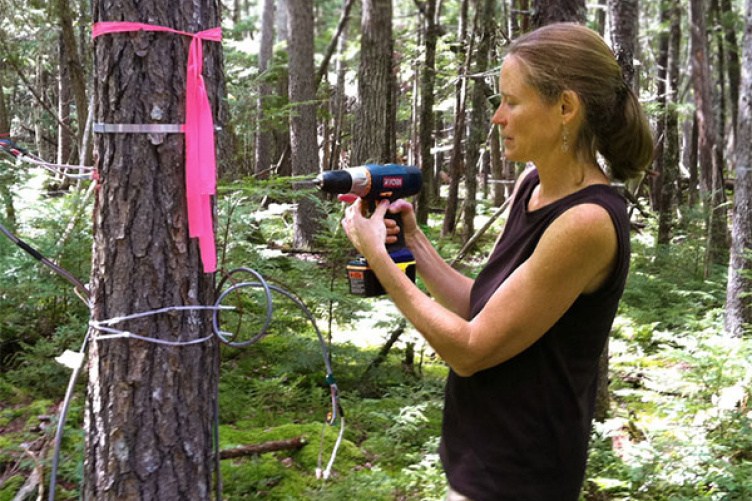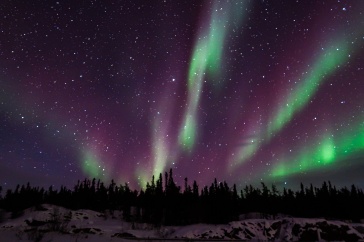
Heidi Asbjornsen installs heat ratio sensors in sapwood to measure water flow velocity. Photos by Michelle Day, UNH-EOS.
How much water does a forest drink? Give Heidi Asbjornsen a tree and a heat ratio sensor and she’ll give you an answer.
Using three separate probes inserted into sapwood, the sensor emits a pulse of heat and then takes two temperature readings. The combined measurements provide a tree’s water flow velocity. Add a few additional “whole tree physical measurements,” do a bit of multiplication to scale things up and, voilà, you have the estimated total water usage for the trees in the forest.
It is a powerful scientific tool, and when Asbjornsen arrived at UNH from Iowa State University in 2010 as part of an eight-faculty, interdisciplinary, agro-ecosystems cluster hire, she immediately infused previous research at the Earth Systems Research Center (ESRC) with new life.
That research, led by Scott Ollinger, involved remote sensing of forest canopies to establish the relationship between leaf nitrogen content, carbon storage, and the reflectivity of leaf surfaces, or “albedo.” Now, Ollinger, ESRC scientist Jingfeng Xiao, and Asbjornsen are collaborating on a new NASA project that adds the role of water to the mix.
Says Asbjornsen, an associate professor with a joint appointment in the Institute for the Study of Earth, Oceans, and Space (EOS) and the department of natural resources and the environment (NREN), “Once you’ve established these strong patterns based on observations, as Scott did, the next question is, what are the underlying reasons or mechanisms that explain these patterns?”
She adds, “To understand these mechanisms, it’s important to measure the leaf- and plant-level physiological processes, such as water and carbon uptake. Then, scaling information from leaves to landscapes requires directly linking information about plant physiology to larger scale measurements.”
Working in the disciplines of ecophysiology—an experimental science that seeks to describe the physiological mechanisms underlying ecological observations—and ecohydrology, Asbjornsen’s ground-level, leaf-to-whole-plant research will complement the larger scale work done by Ollinger and Xiao.
She’ll use tree cores and stable isotope analysis to look at growth over time, going back at least 50 years to determine how trees responded to climate variability.
“We can extract wood from individual tree rings and analyze it for stable isotopes of carbon-13, which serves as an indicator of water use efficiency,” Asbjornsen says.
Water use efficiency is a measure of a plant’s ability to simultaneously take in or “fix” atmospheric carbon dioxide through tiny leaf pores called stomata without losing too much water during the process of photosynthesis. Among other things, it is an important indicator of the capacity of trees and forests to maintain their productivity during environmentally stressful periods, such as extreme drought events or heat waves.
“There is an inherent trade-off between carbon fixation and water use,” notes Asbjornsen, “and when vegetation is changed on a landscape, for example a forest is converted to crops, this can change the balance.”
Agro-ecosystem trade-offs
|
Asbjornsen on the páramo—an alpine tundra ecosystem—in Colombia this past summer. Photo by L. Bruijnzeel, Free University-Amsterdam. |
Analyzing these inherent trade-offs when landscapes are significantly altered is part and parcel of work Asbjornsen is doing as a member of the agro-ecosystem group hired through the College of Life Sciences and Agriculture. The faculty members are, among other things, investigating various environmental implications of increasing food production in New Hampshire and New England.
The initiative encompasses analyzing how changes in land use could affect water resources, water quality, flooding and water scarcity, as well as other ecosystem services such as carbon storage.
“My work in Iowa was more agriculturally focused and included research in prairie systems as well as savannah/woodlands and how the integration of these perennial vegetative covers within agriculturally dominated landscapes can help reduce negative environmental impacts,” says Asbjornsen. “Here, the situation is kind of flipped because the landscape is primarily forested.”
Indeed, compared to Midwest agriculture, the Northeast is a mere bump on the landscape and part of the initial work for the agro-ecosystem group is to get a better understanding of current and potential future trajectories of agriculture in New England and how the public at large perceives and values these changes—the latter being anything but clear.
“The first step for us is to establish the relevance and importance of agriculture and agricultural expansion in New England,” Asbjornsen says. “We need to understand the implications and potential environmental impacts of increased local food production.”
With these data in hand, the researchers will then look into how landscapes could be designed and configured to maximize agricultural production while at the same time maintaining key ecosystem services that ensure water and soil quality and biodiversity, for example.




















































